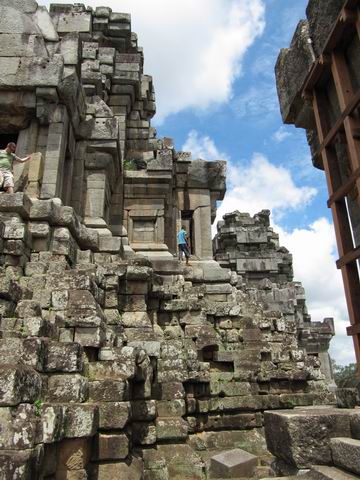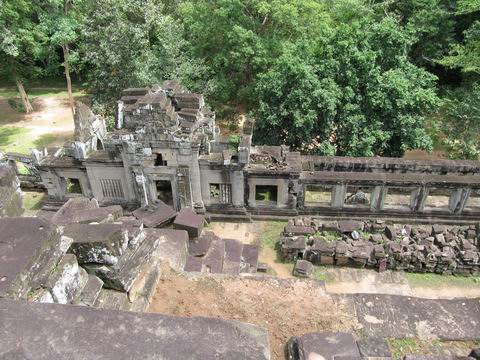Takeo was probably built between 980 and 1013, started by Jayavarman V but largely completed by Suryavarman I. This fact and the fact that the Khmer empire was at that time unstable might be an explanation why it appears to be unfinished.
Takeo is the most classical example of a Khmer temple-mountain.
Built on the principle started with Bakong and largely improved with Pre Rup, Takeo consists of three successive layers of decreasing size with steps on each side, five prasats at the top and the whole structure surrounded by a moat, representing Mount Meru . However, at Takeo, new elements (from the Khleang-style) were introduced: a surrounding gallery at the second level, entrance pavilions (gopurams) at the galleries of a cruciform shape, 2 buildings that we now call libraries and 4 buildings of unknown function best described as long chambers, and the fact that this is the first temple entirely built of sandstone. The sandstone used is of a particular hard kind, feldspatic wacke, which might be an explanation why most of the blocks are unusually large and why most of the temple is undecorated. This lack of decoration is another feature that contributes to the massiveness, to the almost literally unpolished state of the temple. There are some carvings, however, these are of a very fine quality and makes one wonder in an almost melancholy way how Takeo would have looked like if all this work was finished. But this is it, this is how we now see Takeo, and this keeps the temple in its own right and as an almost perfect counterpart of the fully-decorated Banteay Srei temple, built at the same time and under the same reign. |
|

Towers that clearly show the large size and rudeness of the building blocks. |
The galleries are quite special: there are no doors, just windows, and there is no roof, but probably that actually was in place, but built from wood and thus vanished over time. This photo also shows one of the gopurams (pavilions). |
|
 |